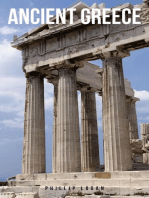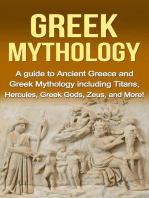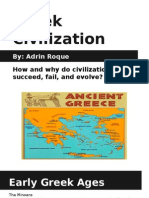0 ratings0% found this document useful (0 votes)
1 viewsANCIENT-GREEK-STATES
ANCIENT-GREEK-STATES
Uploaded by
bianca magluyanCopyright:
© All Rights Reserved
Available Formats
Download as DOCX, PDF, TXT or read online from Scribd
ANCIENT-GREEK-STATES
ANCIENT-GREEK-STATES
Uploaded by
bianca magluyan0 ratings0% found this document useful (0 votes)
1 views16 pagesCopyright
© © All Rights Reserved
Available Formats
DOCX, PDF, TXT or read online from Scribd
Share this document
Did you find this document useful?
Is this content inappropriate?
Copyright:
© All Rights Reserved
Available Formats
Download as DOCX, PDF, TXT or read online from Scribd
Download as docx, pdf, or txt
0 ratings0% found this document useful (0 votes)
1 views16 pagesANCIENT-GREEK-STATES
ANCIENT-GREEK-STATES
Uploaded by
bianca magluyanCopyright:
© All Rights Reserved
Available Formats
Download as DOCX, PDF, TXT or read online from Scribd
Download as docx, pdf, or txt
You are on page 1of 16
EUROPEAN POLITICS REPORTING
Aynaga, Charyl
Bayoneta, Shailene
Morga, Micah Ella
Osunero, Ma. Josepha
Sudario, Krisdan
THE ANCIENT GREEK CITY-STATES
The Early Iron Age and the Formation of the City-States
The Iron Age was a period in human history that started between 1200 B.C. and
600 B.C., depending on the region, and followed the Stone Age and Bronze Age.
During the Iron Age, people across much of Europe, Asia and parts of Africa began
making tools and weapons from iron and steel. For some societies, including
Ancient Greece, the start of the Iron Age was accompanied by a period of cultural
decline.
Humans may have smelted iron sporadically throughout the Bronze Age, though
they likely saw iron as an inferior metal. Iron tools and weapons weren’t as hard or
durable as their bronze counterparts.
The use of iron became more widespread after people learned how to make steel, a
much harder metal, by heating iron with carbon. The Hittites—who lived during
the Bronze Age in what is now Turkey—may have been the first to make steel.
The Iron Age began around 1200 B.C. in the Mediterranean region and Near East
with the collapse of several prominent Bronze Age civilizations, including the
Mycenaean civilization in Greece and the Hittite Empire in Turkey. Ancient cities
including Troy and Gaza were destroyed, trade routes were lost and literacy
declined throughout the region.
The Mycenaean civilization, which dominated the Greek world during the Late
Bronze Age, collapsed around 1200 BCE. This event is often associated with the
Dorian invasions and the end of the palatial system of governance. As a result,
Greece entered a period of decline known as the “Greek Dark Ages”.
The cause for the collapse of these Bronze Age kingdoms remains unclear.
Archaeological evidence suggests a succession of severe droughts in the eastern
Mediterranean region over a 150-year period from 1250 to 1100 B.C. likely figured
prominently in the collapse. Earthquakes, famine, sociopolitical unrest and
invasion by nomadic tribes may also have played a role. Some experts believe that
a disruption in trade routes may have caused shortages of the copper or tin used to
make bronze around this time. Metal smiths, as a result, may have turned to iron as
an alternative.
During the Dark Ages (c. 1200 BCE – 800 BCE), Greece was divided into small,
isolated villages. However, by the 8th century BCE, these communities began to
emerge as city-states, known as *poleis* (singular: *polis*). Each city-state was a
self-governing political entity, often centered around a single city and its
surrounding territory. The mountainous terrain of Greece made large, unified
kingdoms difficult to maintain. Instead, city-states developed their own distinct
cultures, laws, and governments, often in competition with one another. These city-
states were fiercely independent but shared cultural elements like language,
religion, and the Olympic Games.
Archaic Period (circa 800-480 BCE)
During the Archaic period, Greece was not a unified nation but rather a collection
of independent city-states known as poleis. Each polis functioned like a small
country with its own government, laws, and customs. The development of city-
states laid the foundation for political experimentation and diversity in governance,
ranging from monarchies to oligarchies and early democracies.
During the Colonization Era Greeks established colonies throughout the
Mediterranean and Black Sea regions. This expansion was driven by factors such
as trade opportunities, population pressures, and the search for fertile land.
Colonization spread Greek culture, language, and political ideas across a wide
area, influencing local populations and facilitating cultural exchange. Moreover,
the rise of Political Developments many Greek city-states transitioned from
monarchies to more complex forms of government. In Athens, reforms by leaders
like Solon and Cleisthenes paved the way for democracy. Why It Matters? these
political changes introduced concepts of citizenship and civic participation that
would later influence democratic systems worldwide.
The Archaic period of cultural flourishing saw significant advancements in art and
literature. The creation of epic poetry, such as Homer’s “Iliad” and “Odyssey,”
became foundational texts of Western literature. These cultural achievements set
the stage for the artistic and intellectual developments of the Classical period. And
military Innovations, the hoplite phalanx, a military formation of heavily armed
infantry soldiers, became the standard in Greek warfare. This innovation
emphasized discipline and unity, contributing to the success of Greek armies in
battles.
The following are the great contribution during the Archaic Period:
Art and Architecture: Characterized by the use of geometric patterns and the
emergence of more naturalistic styles in sculpture, leading to the iconic kouros and
kore statues.
Literature and Philosophy: Early philosophical thought began to emerge, laying the
groundwork for later classical philosophy.
Religion and Mythology: The pantheon of Greek gods and myths became more
systematized during this time.
Classical Period (circa 480-323 BCE)
The Classical period began with the Greek victory over the Persian Empire in a
series of conflicts known as the Persian Wars. Key battles included Marathon,
Thermopylae, and Salamis. These victories preserved Greek independence and
allowed for the continued development of Greek culture and political systems.
The Persian Empire, under kings like Darius and Xerxes, sought to expand into
Greece, prompting a series of wars. Major battles like the Battle of Marathon (490
BCE) and the Battle of Thermopylae (480 BCE) marked a defining moment in
Greek unity. Though the city-states were often divided, they came together to fight
a common enemy. The Greek victories ensured the survival of the city-states and
their culture.
Golden Age of Athens under the leadership of Pericles, Athens experienced a
cultural and political golden age. This era saw the construction of iconic structures
like the Parthenon and the flourishing of arts and philosophy. Athens became a
center of learning and culture, producing works and ideas that have had a lasting
impact on Western civilization.
After the Persian Wars, Athens led the creation of the Delian League, a coalition of
city-states designed to defend against further Persian aggression. However, Athens
gradually turned the League into an empire, consolidating power and wealth.
Tensions between Athens and Sparta, two dominant Greek city-states, erupted in
the Peloponnesian War. Athens, with its navy, and Sparta, with its military prowess,
fought a brutal conflict that lasted for nearly three decades. Sparta ultimately won,
but the war devastated many Greek city-states and weakened Greek unity.
The Era of Peloponnesian War a long and destructive conflict between Athens and
Sparta, along with their respective allies, known as the Peloponnesian War,
ultimately led to the decline of Athenian power. The war weakened the major
Greek city-states, making them vulnerable to external threats and internal strife.
During the 5th century BCE, especially under the leadership of Pericles, Athens
experienced a cultural and intellectual flourishing. This era saw the construction of
the Parthenon, the rise of democracy, and the work of philosophers such as
Socrates, Plato, and Aristotle. Sparta, in contrast to Athens, was a militaristic
society. Its rigid social structure focused on discipline and warfare, and it played a
leading role in the Peloponnesian League, a group of city-states that opposed
Athenian dominance.
Rise of Macedon the period concluded with the rise of Macedon under Philip II
and his son Alexander the Great, who expanded Greek influence through his
conquests across Asia and Egypt. Alexander’s conquests spread Greek culture and
ideas far beyond the traditional Greek world, leading to the Hellenistic period.
Cultural Contributions during classical Period
Art and Architecture: The Classical period is renowned for its advancements in art
and architecture, including the development of the Doric, Ionic, and Corinthian
orders in architecture and the creation of lifelike sculptures by artists like Phidias
and Praxiteles.
Drama and Literature: The period saw the birth of Western drama, with
playwrights like Aeschylus, Sophocles, and Euripides in tragedy, and Aristophanes
in comedy.
Science and Mathematics: Figures such as Hippocrates in medicine and Euclid in
mathematics made significant contributions that would influence future
generations.
Philosophy: Philosophers like Socrates, Plato, and Aristotle laid the foundations for
Western philosophical thought. Drama and Literature: The birth of Western drama
occurred during this time, with playwrights like Aeschylus, Sophocles, and
Euripides in tragedy, and Aristophanes in comedy.
Key takeaways.
•Archaic Period (circa 800-480 BCE) Archaic period, Greece was not a unified
nation but rather a collection of independent city-states known as poleis
•Development of city-states laid the foundation, ranging from monarchies to
oligarchies and early democracies.
•Colonization spread Greek culture, language, and political ideas across a wide
area, influencing local populations and facilitating cultural exchange.
•In Athens, reforms by leaders like Solon and Cleisthenes paved the way for
democracy.
•The creation of epic poetry, such as Homer’s “Iliad” and “Odyssey,” became
foundational texts of Western literature.
•Art and Architecture, Literature and Philosophy, Religion and Mythology these
are the great contributions in Archaic Period.
•Classical Period (circa 480-323 BCE)
•The Classical period began with the Greek victory over the Persian Empire in a
series of conflicts known as the Persian Wars.
•Golden Age of Athens, under the leadership of Pericles this era saw the
construction of iconic structures like the Parthenon and the flourishing of arts and
philosophy.
•The Era of Peloponnesian War, a long and destructive conflict between Athens
and Sparta, along with their respective allies, known as the Peloponnesian War.
•Rise of Macedon the period concluded with the rise of Macedon under Philip II
and his son Alexander the Great.
•Cultural Contributions during classical Period: Art and Architecture, Drama and
Literature, Philosophy.
The Hellenistic Periods
Spans from the death of Alexander the Great in 323 BCE to the Roman conquest of
the Greek world, culminating with the fall of the Ptolemaic Kingdom in Egypt in
30 BCE. This era is characterized by the spread of Greek culture across a vast
empire and significant developments in various fields. The death of the
Macedonian king Alexander the Great in 323 BCE marked the end of the Classical
period and the beginning of the Hellenistic period. Alexander's empire spanned
from Greece to Egypt and into India, spreading Greek culture throughout the
known world.
Historical Overview Division of Alexander’s Empire:
After Alexander’s death, his empire was divided among his generals, known as the
Diadochi. This led to the formation of several Hellenistic kingdoms, including the
Ptolemaic Kingdom in Egypt, the Seleucid Empire in Persia, and the Antigonid
dynasty in Macedonia. Greek culture, language, and ideas spread throughout the
Mediterranean and Near East, blending with local cultures. This cultural
syncretism is a hallmark of the Hellenistic period. The period was marked by
frequent conflicts among the Hellenistic kingdoms and internal strife, as rulers vied
for power and territory.
Over time, Rome emerged as a dominant power, gradually absorbing Hellenistic
territories. Key events include the defeat of Macedon in the Macedonian Wars and
the annexation of Egypt following Cleopatra VII’s reign.
Greek art and life had always been influenced by other cultures, but the expansion
in territory during Alexander the Great's conquests brought greater possibilities for
mutual cultural exchanges. These exchanges led to a new cosmopolitanism in the
Greek world and influenced the desire to understand, appreciate, and represent the
diversity of individual peoples. Greater mobility made possible by territorial
expansion also encouraged people to seek a sense of purpose and belonging.
Philosophy and other intellectual pursuits, which developed in great strides during
the Hellenistic period, provided a means of exploring one's emotions and seeing
the world and it was during this time that philosophers such as Epicurus (341-270
B.C.E.) and Diogenes of Sinope (c. 404-323 B.C.E.) found their followings and
influenced the succeeding generations.
The Greek city-states gradually lost their independence due to external pressures,
including the rise of the Roman Republic. In 146 BCE, Greece was incorporated
into the Roman Republic after the Battle of Corinth, marking the end of the era of
the independent Greek city-states.
Hellenistic Periods Key Takeaways:
Cultural Overview Art and Architecture: Hellenistic art is noted for its diversity
and realism, moving away from the idealized forms of the Classical period. It often
depicted dramatic expressions and dynamic poses. Notable works include the
Venus de Milo and the Laocoön Group.
Philosophy and Science: The period saw the rise of new philosophical schools,
such as Stoicism, Epicureanism, and Skepticism. Advances in science and
mathematics were made by figures like Archimedes, Euclid, and Eratosthenes.
Literature and Theatre: Literature flourished with poets like Callimachus and
Theocritus. Theatrical productions continued to be popular, with an emphasis on
comedy, exemplified by playwrights like Menander.
Religion and Spirituality: Traditional Greek religious practices persisted, but there
was also an increase in mystery religions and the worship of syncretic deities,
reflecting the blending of cultures.
Urbanization and Economy: The Hellenistic period saw the growth of large,
cosmopolitan cities such as Alexandria, Antioch, and Pergamon. These cities
became centers of trade, learning, and culture, fostering economic prosperity.
Libraries and Learning: The Library of Alexandria became a symbol of the
intellectual achievements of the era, housing vast collections of texts and attracting
scholars from across the known world.
Key City-States in Ancient Greece
1. Athína (Athens)
History:
Athens is considered the cradle of Western civilization and democracy. It reached
its zenith during the 5th century BCE, known as the “Golden Age of Athens,”
under leaders like Pericles. Athens was central to the arts, philosophy, and
sciences, producing figures such as Socrates, Plato, and Aristotle. The city was a
significant power during the Greco-Persian Wars and the Peloponnesian War
against Sparta.
Politics and Governance:
Athens is most famous for developing the concept of democracy. Initially an
aristocracy, Athens transitioned to a democracy under leaders like Solon and
Cleisthenes. Citizens (free adult males) participated in the ecclesia (assembly),
which made decisions about laws, war, and foreign policy. A council of 500
(Boule) and various magistrates executed these decisions. However, women,
slaves, and non-citizens had no political rights.
2. Spárti (Sparta)
History:
Sparta was a militaristic and oligarchic society in the southeastern Peloponnesian
region of Laconia. Its culture focused on military excellence and discipline. Unlike
Athens, Sparta avoided grand artistic and intellectual pursuits, concentrating
instead on warfare. The city-state played a key role in the Greco-Persian Wars and
was the leading force in the Peloponnesian War.
Politics and Governance:
Sparta’s government was a mixed system combining monarchy, oligarchy, and
elements of democracy. It had two kings (dual monarchy) who led military
campaigns and religious duties. Governance was overseen by a council of elders
(Gerousia) and an assembly of citizens (Apella). The real power lay with the
Ephors, five annually elected officials who supervised the kings and enforced laws.
Spartan society was strictly hierarchical, with citizens (Spartiates) at the top,
followed by non-citizen free people (Perioeci) and enslaved Helots.
3. Kórinthos (Corinth)
History:
Corinth was a wealthy and influential city-state located on a strategic isthmus
connecting mainland Greece to the Peloponnese. Known for its commerce and
craftsmanship, Corinth controlled key trade routes and developed an impressive
navy. The city was a cultural hub, famous for its temples and the Isthmian Games.
Corinth oscillated between alliances with Athens and Sparta during various
conflicts.
Politics and Governance:
Corinth was originally a monarchy but transitioned to an oligarchic government
ruled by aristocratic families. During the 7th century BCE, tyrants like Cypselus
and his son Periander brought stability and prosperity to the city. The city
maintained a mixed government structure later, involving councils and assemblies,
although power remained concentrated among the elite.
4. Thíva (Thebes)
History:
Thebes was a major city-state in central Greece (Boeotia). It had a complex
relationship with Athens and Sparta, sometimes allying with one or the other.
Thebes played a crucial role in the Battle of Leuctra (371 BCE), where its army,
led by Epaminondas, decisively defeated Sparta, ending Spartan dominance. It was
destroyed by Alexander the Great in 335 BCE as punishment for rebelling against
Macedonian rule.
Politics and Governance:
Theban governance included a mix of aristocracy and democratic elements. The
city was led by elected magistrates and councils. The sacred Band, an elite military
unit composed of 300 pairs of lovers, symbolized Theban military might and social
cohesion. Politics were often shaped by alliances and rivalries with neighboring
states.
5. Siracusa (Syracuse)
History:
Located on the island of Sicily, Syracuse was a powerful city-state and a major
Greek colony. Founded by Corinthians in 733 BCE, it became a cultural and
military powerhouse. Syracuse famously resisted Athenian forces during the
Sicilian Expedition (415-413 BCE), a turning point in the Peloponnesian War. The
city later faced threats from Carthage and Rome before falling under Roman rule in
212 BCE.
Politics and Governance:
Syracuse experienced periods of tyranny interspersed with democratic rule. Tyrants
like Gelon and Dionysius I expanded the city’s power and infrastructure.
Syracuse’s political system combined a citizen assembly with leadership under
strong rulers who often wielded near-absolute authority. During times of
democracy, citizens had significant influence over decisions, but tyranny returned
during times of instability.
6. Égina (Aegina)**
History:
Aegina was an important ancient Greek city-state located on an island in the
Saronic Gulf. It flourished during the 6th century BCE and was known for its
powerful navy. The island was one of the major rivals of Athens during the early
Classical period, particularly in the 5th century BCE. Aegina's prosperity was
based on trade, particularly in pottery and, later, silver from its mines.
Politics and Governance:
Aegina was initially ruled by aristocrats, but over time, it moved towards a more
democratic system. Its governance was marked by the influence of a few powerful
families and oligarchic structures. At various points, the city-state was ruled by
tyrants, such as Pythagoras and later by influential figures like the banking family
of the Muses. Politically, it often clashed with Athens, especially during the
Peloponnesian War. In 480 BCE, the island was invaded by the Persian Empire but
later regained independence after the Persian defeat at Salamis.
7. Ródos (Rhodes)
History:
Rhodes was an island city-state that emerged as a major maritime power,
particularly in the Hellenistic period. Located at the crossroads of the Aegean and
Eastern Mediterranean, Rhodes became famous for its strategic location and its
wealthy economy, built on trade and shipbuilding. Rhodes' greatest architectural
achievement was the construction of the Colossus of Rhodes, one of the Seven
Wonders of the Ancient World. It flourished from the 4th century BCE, especially
after the unification of the island under the leadership of the Ptolemies.
Politics and Governance:
Rhodes was initially governed by oligarchic systems, and its politics revolved
around the rich merchant families and the influential naval commanders. By the
5th century BCE, it had established a degree of democracy, though power remained
in the hands of a few. The city was also known for its emphasis on diplomacy and
was a key player in Mediterranean politics, often mediating between larger powers
like Athens and Sparta. Rhodes remained independent until it was absorbed by
Rome in 43 BCE.
8. Árgos
History:
Argos was one of the oldest and most important cities in ancient Greece, with a
history that stretches back to the Bronze Age. It was a center of Mycenaean
civilization and later emerged as a key city-state in the Archaic and Classical
periods. Argos had a powerful army and was renowned for its artistic and cultural
achievements, including contributions to sculpture and pottery.
Politics and Governance:
Initially, Argos was ruled by kings, the most famous being the Heracleidae dynasty,
which produced legendary figures like Perseus and Heracles. By the 6th century
BCE, Argos transitioned to a more oligarchic system and was later governed by
democratic institutions. During the 5th century BCE, Argos played a significant
role in resisting the Persian invasion. The city was politically independent for
much of its history, though it eventually lost power to Sparta after the
Peloponnesian War and the rise of Macedon in the 4th century BCE.
9. Erétria (Euboea)
History:
Eretria, located on the island of Euboea, was an ancient Greek city-state known for
its trade and colonization efforts. It was one of the major rivals of Chalcis on
Euboea and engaged in frequent conflicts over control of the island. Eretria was
also known for its contributions to Greek art and philosophy.
Politics and Governance:
Eretria initially operated as an oligarchic system but later embraced democracy.
During the 6th century BCE, the city was ruled by powerful tyrants, and in the 5th
century, it developed democratic institutions. Eretria was heavily involved in the
Persian Wars, siding with Athens against the Persians. However, the city was later
conquered by Macedon and never fully regained its former prominence after the
4th century BCE.
10. Elis
History:
Elis was a region in the northwest of the Peloponnese, known for its religious
significance, most notably as the site of the ancient Olympic Games. The city-state
of Elis was important for its role in organizing the Olympic Games, which were
held every four years to honor Zeus. Although it was not as militarily powerful as
some other Greek city-states, its cultural and religious influence was considerable.
Politics and Governance:
Elis was ruled by a mix of oligarchy and local elites, and its political system
revolved around the powerful families who controlled the land. Unlike other city-
states, it did not have a large standing army or navy. Instead, its prestige was
derived from its religious role. During the 5th and 4th centuries BCE, Elis was
often in conflict with neighboring Sparta, especially over control of the Olympic
Games. Elis eventually fell under Macedonian influence after the rise of Philip II.
Keytakeways:
Athína (Athens)
Democratic Legacy: Athens introduced democracy, where free male citizens
directly participated in decision-making.
Cultural Hub: Athens was a center of art, philosophy, and science, influencing
Western thought.
Golden Age: Flourished under leaders like Pericles, especially during the 5th
century BCE.
Exclusivity: Political participation was limited to free male citizens, excluding
women, slaves, and non-citizens.
Spárti (Sparta)
Military Focus: A society centered on discipline, warfare, and military training.
Mixed Government: Combined monarchy, oligarchy, and democratic elements,
with Ephors holding significant power.
Social Hierarchy: Strictly divided into Spartiates (citizens), Perioeci (non-citizen
free people), and Helots (enslaved population).
Key Role in Wars: Played a leading role in both the Greco-Persian Wars and the
Peloponnesian War.
Kórinthos (Corinth)
Commercial Powerhouse: Wealth derived from trade due to its strategic location on
the isthmus.
Cultural Achievements: Known for its temples, craftsmanship, and hosting the
Isthmian Games.
Government Evolution: Transitioned from monarchy to oligarchy and experienced
periods of tyranny that brought stability.
Strategic Influence: Played a key role in Greek alliances and conflicts due to its
naval power.
Thíva (Thebes)
Military Excellence: Known for its victory over Sparta at the Battle of Leuctra,
ending Spartan dominance.
Dynamic Alliances: Shifted allegiances between Athens and Sparta based on
strategic needs.
Sacred Band: Celebrated for its elite military unit, emphasizing discipline and
unity.
Political Shifts: Mixed governance with aristocratic and democratic elements
shaped its leadership.
Siracusa (Syracuse)
Colonial Power: A significant Greek colony that became a military and cultural
leader in Sicily.
Resilience: Successfully resisted Athenian invasion during the Sicilian Expedition.
Tyrannical and Democratic Phases: Experienced periods of tyranny under leaders
like Gelon and Dionysius I, interspersed with democratic governance.
Cultural Influence: Played a crucial role in spreading Greek culture in the Western
Mediterranean.
General Insight:
Each city-state had a unique identity influenced by its geography, economy, and
sociopolitical structure, collectively shaping ancient Greece’s legacy in politics,
culture, and warfare.
Here are the key takeaways from the history, politics, and governance of Égina
(Aegina), Ródos (Rhodes), Árgos, Erétria, and Elis:
1. Égina (Aegina)
- Strategic Location: An important maritime power in the Saronic Gulf.
Rivalry with Athens: Engaged in intense rivalry with Athens, especially during
the 5th century BCE.
Governance: Transitioned from aristocracy to more democratic systems, though
oligarchic influences remained.
Naval Power: Known for its strong navy and trade, particularly in silver.
2. Ródos (Rhodes)
Maritime Influence: Became a powerful naval city-state, crucial in
Mediterranean trade and diplomacy.
Cultural and Architectural Achievements: Famous for the Colossus of Rhodes, one
of the Seven Wonders of the Ancient World.
Governance: Initially ruled by oligarchs, it later embraced democracy. Known for
its diplomatic neutrality and influence in the Mediterranean.
Decline: Fell under Roman control in 43 BCE.
3. Árgos
Historical Significance: One of Greece’s oldest city-states, with strong ties to
Mycenaean civilization.
Cultural Contributions: Famous for its art, sculpture, and military innovations.
Governance: Transitioned from monarchy to oligarchy and later democracy.
Power Shift: Lost influence to Sparta and later to Macedonia in the 4th century
BCE.
4. Erétria (Euboea)
Rivalry with Chalcis: Frequently in conflict with its neighboring city-state,
Chalcis.
Trade and Colonization: Known for its strong economy based on trade and
colonization efforts.
Governance: Moved from tyrannical rule to democracy during the 5th century
BCE.
Persian Wars: Participated in the Persian Wars but lost power after the rise of
Macedon.
5. Elis
Olympic Legacy: Known for its role in organizing the ancient Olympic Games.
Religious Significance: Played a major role in the religious and cultural life of
ancient Greece.
Governance: Governed by local elites and oligarchs, with no large military or
naval forces.
Decline: Fell under Macedonian control, with less influence after the 4th century
BCE.
General Takeaways:
Political Systems: These city-states had varied forms of governance, including
monarchies, oligarchies, and democracies.
Cultural and Religious Influence: Many, such as Elis, were known for cultural or
religious contributions (like the Olympic Games).
Rivalries and Conflicts: Many city-states, especially Aegina and Rhodes, were
involved in power struggles with Athens and Sparta, which shaped their histories.
Strategic Importance: Their locations were crucial for trade and military influence,
with strong navies or military forces.
Decline: Many of these city-states lost their independence after being absorbed into
larger empires like Macedonia and later Rome.
These cities exemplified the diversity of governance and power structures in
ancient Greece while all playing significant roles in the region's politics, culture,
and military conflicts.
You might also like
- Western Civilization: Ch. 3Document7 pagesWestern Civilization: Ch. 3LorenSolsberry67% (3)
- Aristotle On CitizenshipDocument22 pagesAristotle On CitizenshipSrishti100% (6)
- Ancient Greek Activities (1) - 3-9Document7 pagesAncient Greek Activities (1) - 3-9valentina chelodiNo ratings yet
- Amsco Chapter 3 - StudentDocument16 pagesAmsco Chapter 3 - StudentKimberlyNo ratings yet
- Kojin Karatani - Isonomia and The Origins of PhilosophyDocument165 pagesKojin Karatani - Isonomia and The Origins of PhilosophyRafael Saldanha100% (1)
- Ancient GreeceDocument5 pagesAncient GreeceNeri dacanayNo ratings yet
- Dgtal PathwayDocument7 pagesDgtal PathwayKelvin WinataNo ratings yet
- Ancient GreeceDocument12 pagesAncient GreeceAngela PageNo ratings yet
- Ancient Greece: From Wikipedia, The Free EncyclopediaDocument16 pagesAncient Greece: From Wikipedia, The Free Encyclopediaanku5108100% (1)
- Iron Age CivilizationDocument48 pagesIron Age CivilizationThulla SupriyaNo ratings yet
- Greek CivilizationDocument34 pagesGreek Civilizationprincexerox2No ratings yet
- ANTIQUITYDocument41 pagesANTIQUITYMeryemNo ratings yet
- Anciant GreeceDocument2 pagesAnciant GreeceTiruvalli ManikantaNo ratings yet
- From Bronze Age to Roman CivilizationDocument8 pagesFrom Bronze Age to Roman Civilizationhabibaamahmed453No ratings yet
- Ancient Greece: The Birth of The City-StateDocument2 pagesAncient Greece: The Birth of The City-StateYuri PamaranNo ratings yet
- Ancient GreeceDocument39 pagesAncient GreeceSantiago Zurita100% (2)
- greekDocument2 pagesgreekFardeen RahmanNo ratings yet
- Ancient Greece - Wikipedia, The Free EncyclopediaDocument17 pagesAncient Greece - Wikipedia, The Free Encyclopediasandra072353No ratings yet
- Linguistic Evidence On The Macedonian Question (By Ioannis Kallianiotis)Document22 pagesLinguistic Evidence On The Macedonian Question (By Ioannis Kallianiotis)Macedonia - The Authentic TruthNo ratings yet
- Ancient GreeceDocument15 pagesAncient Greeceaquel1983No ratings yet
- Ancient GreeceDocument2 pagesAncient GreeceAriel Molina MagañaNo ratings yet
- Greece 7Document3 pagesGreece 7Irfanullah ChhajroNo ratings yet
- Ancient Greece (: Hellás) Was ADocument2 pagesAncient Greece (: Hellás) Was AJack SwaggerNo ratings yet
- 2024-09!01!17!42!31 WPJGqB5DPDbogzoPRoPkbolYz9So7eEDw8J6nb7V (1)Document4 pages2024-09!01!17!42!31 WPJGqB5DPDbogzoPRoPkbolYz9So7eEDw8J6nb7V (1)calendar.lukaNo ratings yet
- GReek PoetryDocument24 pagesGReek Poetryjij66861No ratings yet
- Ancient Greece: Navigation SearchDocument22 pagesAncient Greece: Navigation SearchashwinisathyaNo ratings yet
- PDF 2Document2 pagesPDF 2BorisNo ratings yet
- The Rise and Fall of Greek City States 1Document3 pagesThe Rise and Fall of Greek City States 1probitsadorospecNo ratings yet
- Greek Mythology: A Guide to Ancient Greece and Greek Mythology including Titans, Hercules, Greek Gods, Zeus, and More!From EverandGreek Mythology: A Guide to Ancient Greece and Greek Mythology including Titans, Hercules, Greek Gods, Zeus, and More!No ratings yet
- Ancient GreeceDocument11 pagesAncient Greecejij66861No ratings yet
- Antik Yunanaistan2Document14 pagesAntik Yunanaistan2ONUR OZSOYNo ratings yet
- Alexander S EmpireDocument5 pagesAlexander S EmpireFlorenvuksaNo ratings yet
- A History of the Classical World: The Story of Ancient Greece and RomeFrom EverandA History of the Classical World: The Story of Ancient Greece and RomeNo ratings yet
- Ancient GreeceDocument39 pagesAncient GreeceSaymon Casilang SarmientoNo ratings yet
- Timeline Ancient GreeceDocument4 pagesTimeline Ancient GreeceSasha KovalevaNo ratings yet
- D 11 LiteratureDocument14 pagesD 11 LiteratureMohasin Niloy Ahmed 2121497642No ratings yet
- Persian Ay - 4Document3 pagesPersian Ay - 4apwhhchsNo ratings yet
- THE HISTORY OF GREECE (Part 1)Document2 pagesTHE HISTORY OF GREECE (Part 1)ayyash lukmanNo ratings yet
- The Myth of Athenian DemocracyDocument29 pagesThe Myth of Athenian DemocracyJ CooperNo ratings yet
- Ancient Greece Was ADocument17 pagesAncient Greece Was AFernán GaillardouNo ratings yet
- Ancient Greek CultureDocument108 pagesAncient Greek CultureYashika TharwaniNo ratings yet
- Ancient Greek CivilisationDocument17 pagesAncient Greek CivilisationSanditi Gargya100% (1)
- Survey in The Western CivilizationDocument11 pagesSurvey in The Western CivilizationJerome EncinaresNo ratings yet
- Chapter 3 The Greeks (History of Western Civilization) - 2Document31 pagesChapter 3 The Greeks (History of Western Civilization) - 2bc190405823No ratings yet
- Thesis Ancient GreeceDocument5 pagesThesis Ancient Greecemelissawilsonmanchester100% (2)
- The Graeco - Roman MediterraneanDocument27 pagesThe Graeco - Roman MediterraneanourbookNo ratings yet
- Ancient GreeceDocument21 pagesAncient GreeceTamer BhuiyannNo ratings yet
- Greek Civilization and Culture: Ancient GreeceDocument64 pagesGreek Civilization and Culture: Ancient GreeceKai GrenadeNo ratings yet
- A Timeline of History and Civilizations of Greece - History 4th Grade Book | Children's European HistoryFrom EverandA Timeline of History and Civilizations of Greece - History 4th Grade Book | Children's European HistoryNo ratings yet
- THE HISTORY OF GREECE (Part 2)Document2 pagesTHE HISTORY OF GREECE (Part 2)ayyash lukmanNo ratings yet
- Art Assignment 2 PDFDocument4 pagesArt Assignment 2 PDFmohameddohenNo ratings yet
- AR 206 History of Architecture, Art & Culture IiDocument74 pagesAR 206 History of Architecture, Art & Culture IiSomi SareenNo ratings yet
- GreeceDocument21 pagesGreeceapi-276881923No ratings yet
- GREEK HISTORY: A PresentationDocument24 pagesGREEK HISTORY: A Presentationapi-19918521100% (2)
- The Rise and Fall of Greek City-StatesDocument38 pagesThe Rise and Fall of Greek City-Statesトロイ ペジ エコランゴ100% (1)
- Lecture 9 The Greek Civilization The Forming of Greek CivilizationDocument53 pagesLecture 9 The Greek Civilization The Forming of Greek CivilizationIlmiat FarhanaNo ratings yet
- Ancient Greece, Rise and Fall: Ancient Worlds and Civilizations, #6From EverandAncient Greece, Rise and Fall: Ancient Worlds and Civilizations, #6No ratings yet
- Ancient Greece - WikipediaDocument55 pagesAncient Greece - Wikipediaalapideeric75No ratings yet
- LETTERDocument1 pageLETTERbianca magluyanNo ratings yet
- Consent Form TemplateDocument1 pageConsent Form Templatebianca magluyanNo ratings yet
- Polsci 3 Public SpeakingDocument5 pagesPolsci 3 Public Speakingbianca magluyanNo ratings yet
- Format For Listing of Educational AssistanceDocument1 pageFormat For Listing of Educational Assistancebianca magluyanNo ratings yet
- What Exactly Is Political Science 1Document4 pagesWhat Exactly Is Political Science 1bianca magluyanNo ratings yet
- Bintliff, John - Territorial Behaviour and The Natural History of The GreekDocument98 pagesBintliff, John - Territorial Behaviour and The Natural History of The GreekGracoNo ratings yet
- A Brief History of GreeceDocument2 pagesA Brief History of GreeceGina GawonNo ratings yet
- Get (Original PDF) Ancient Greece: A Political, Social, and Cultural History 4th Edition PDF Ebook With Full Chapters NowDocument41 pagesGet (Original PDF) Ancient Greece: A Political, Social, and Cultural History 4th Edition PDF Ebook With Full Chapters Nowrafdhuiji100% (8)
- Questioning The AuthorDocument3 pagesQuestioning The Authorapi-436878186No ratings yet
- Aja 123 4 0589Document30 pagesAja 123 4 0589Σέρχιο ΙσπανίαNo ratings yet
- Greek CivilizationDocument22 pagesGreek CivilizationSittie Farhanna MutinNo ratings yet
- The Economics of Ancient GreeceDocument70 pagesThe Economics of Ancient GreeceJon GoldmanNo ratings yet
- 2.1 Study & Analysis of Urban Spaces in History in The WestDocument29 pages2.1 Study & Analysis of Urban Spaces in History in The WestRABIRAJ K (RA1811201010073)No ratings yet
- Intro To Greek CultureDocument26 pagesIntro To Greek CultureaintablianhasmigNo ratings yet
- Summary of Planning of Ancient CivilisationsDocument49 pagesSummary of Planning of Ancient CivilisationsShubhan RathourNo ratings yet
- Ancient GreeceDocument8 pagesAncient GreeceRamita UdayashankarNo ratings yet
- Church and Contemporary IssuesDocument35 pagesChurch and Contemporary Issuesdogara yusuf100% (2)
- An Arbitration Concerning Lampsakos andDocument69 pagesAn Arbitration Concerning Lampsakos andSoner özmenNo ratings yet
- Ancient China and GreeceDocument7 pagesAncient China and GreeceVal DusekNo ratings yet
- Definition, Scope and Utility of Government and Politics-UpgradedDocument14 pagesDefinition, Scope and Utility of Government and Politics-UpgradedPrantoNo ratings yet
- Ancient and Medevial Political Thought Mcq_0Document17 pagesAncient and Medevial Political Thought Mcq_0namratasingh21112004No ratings yet
- Ancient Greece LPDocument2 pagesAncient Greece LPapi-621911859No ratings yet
- Unit 2Document140 pagesUnit 2Y AltonNo ratings yet
- The Economy of Athens in The Classical Era Some AdjustmentsDocument29 pagesThe Economy of Athens in The Classical Era Some AdjustmentsPredrag Judge StanišićNo ratings yet
- Module 2Document14 pagesModule 2marvsNo ratings yet
- Maritime Traders in The Ancient Greek World PDFDocument177 pagesMaritime Traders in The Ancient Greek World PDFSotirios Fotios DrokalosNo ratings yet
- Screenshot 2023-06-28 at 11.33.17 AMDocument40 pagesScreenshot 2023-06-28 at 11.33.17 AMRinkuNo ratings yet
- Unit 7 PPDocument34 pagesUnit 7 PPbtcherryNo ratings yet
- The Polis in Ancient GreeceDocument11 pagesThe Polis in Ancient GreeceVanessa ElkNo ratings yet
- Ancient Greece Flashcards - QuizletDocument6 pagesAncient Greece Flashcards - QuizletTheIntellectualAfrodisiacNo ratings yet
- Cretan Laws and Cretan LiteracyDocument28 pagesCretan Laws and Cretan LiteracyekdorkianNo ratings yet
- Seleukidi PDFDocument228 pagesSeleukidi PDFaurelius777No ratings yet






























































































